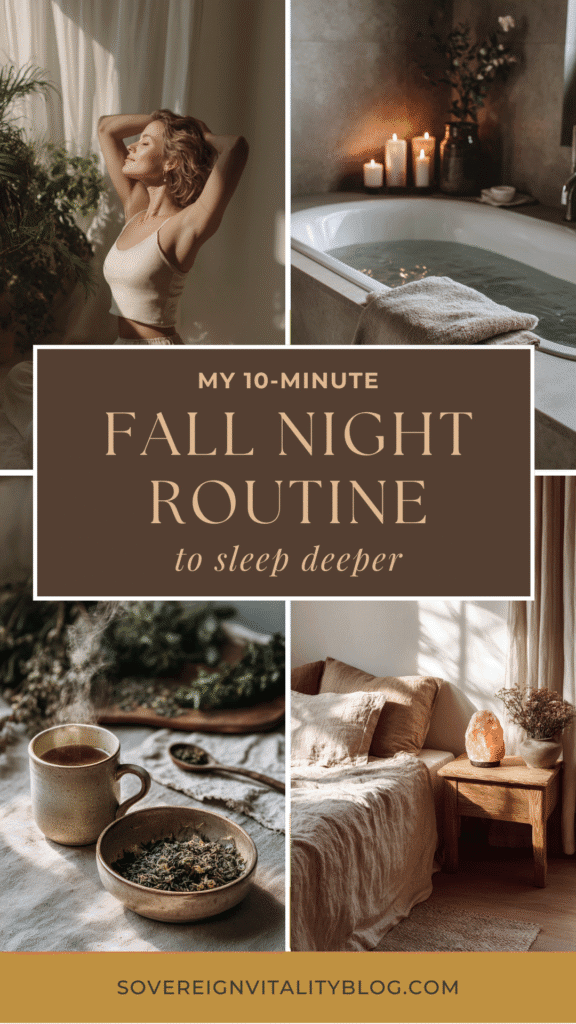This post may contain affiliate links, including those from Amazon Associates. If you make a purchase through these links, I may earn a commission at no additional cost to you. Learn more about our affiliate policy.
When autumn evenings arrive, I often find myself caught between worlds.
Outside, the air whispers of slowing down, but inside, my nervous system buzzes with overstimulation. If you’re familiar with this paradox of feeling simultaneously exhausted and unable to rest, please know you’re in the right company.
Our bodies naturally respond to shorter days and longer nights by adjusting melatonin levels, the hormone guiding sleep. Screens, stress, and seasonal shifts often disrupt these rhythms, amplifying anxiety and sleep struggles.
I spent years wrestling against evening restlessness with elaborate bedtime routines, feeling more exhausted by my efforts.

Eventually, I realized my body didn’t need more complexity, just simpler signals of safety.
Today, my evening rhythm is gentle, brief, and consistent: just ten intentional minutes.
Here’s the nurturing, nervous-system-calming evening routine I’ve developed for deeper sleep, even in autumn’s unsettled moments.
1. Dim the Lights and Signal Sunset to Your Body

Our ancestors relied on natural light to regulate their sleep-wake cycles, but modern life floods us with artificial blue light, especially after sunset.
When I learned how significantly this interfered with melatonin production, I began consciously dimming my lights each evening.
Around an hour before bed, I shift to soft amber lamps, candles, or Himalayan salt lamps. This transition triggers melatonin, guiding my body gently into rest mode on a primal level.
If you tried the “digital sunset” idea from my 10 Simple Fall Nervous System Routines to Reclaim Your Calm, you’ve already experienced the power of evening darkness. Continue leaning into low-light rhythms, signaling gently to your body that rest is near.
2. Make an Herbal Transition Tea

One of my favorite ways to shift toward sleep is brewing a calming herbal tea each evening. I love the Calm Tea from Anima Mundi, a loose herbal blend infused with chamomile, rose, ashwagandha, and milky oats. It’s designed specifically to soothe the nervous system and ease stress from overstimulated days.
Creating tea is an ancient evening ritual. As the kettle boils, I take intentional breaths. When the tea steeps, I pause quietly, letting its aroma and warmth anchor my nervous system into peace.
Sometimes, if my body feels particularly overstimulated, I also take my favorite magnesium complex supplement for deeper sleep support.
For more soothing drink options, explore the herbal swap I shared in 5 Easy Fall Morning Routines to Soothe Your Nervous System.
3. Try a Warm Body Reset

Temperature changes deeply signal your body toward rest. On overstimulated evenings, one gentle way to downshift is incorporating warmth.
A long hot shower, a cozy foot soak, or a relaxing epsom salt bath with one of these recipes can recalibrate your nervous system.
Warmth activates parasympathetic pathways, signaling your body it’s safe to slow down and rest.
Some evenings, I follow my warm reset with self-massage, smoothing warm body oil like Anima Mundi’s Rose Body Oil on my arms and feet.
Allow your warm reset to feel luxurious yet simple, a way of honoring of your body’s need for softness at day’s end.
4. 3 Minutes of Breath or Restorative Movement

Breath and gentle movement directly soothe an overstimulated nervous system.
My evening favorites include legs up the wall pose, forward folds, child’s pose, or a simple box-breathing practice (inhale for four counts, hold for four, exhale for four, hold again for four).
These slow, restorative movements or breathing practices signal safety to your vagus nerve, quieting anxiety and lowering your heart rate.
As you try these practices, focus especially on exhaling slowly. Exhalations activate parasympathetic calm.
Find what feels best in your body, allowing softness rather than striving. If morning breathwork resonates with you already (as I shared in 5 Easy Fall Morning Routines to Soothe Your Nervous System), extending that calm breath to evening routines will feel even more soothing.
5. Anchor with One Calming Sensory Ritual
Even after tea, warmth, and breath, sometimes your mind may remain quietly restless. On those nights, sensory anchoring rituals become deeply powerful allies.
Choose something simple: rolling calming essential oils onto your wrists, reading quietly by candlelight, wrapping yourself in a soft blanket, lighting a beeswax candle, or jotting down a single calming affirmation or gratitude line.
These rituals create tangible sensory signals of safety and gently remind my nervous system that rest is now safe and accessible.
If creating sensory safety resonates with you, I share more ideas in my post, How To Create a Nervous System Friendly Sanctuary.
These practices deepen the calm of your living environment, helping you unwind effortlessly each evening.
Gentle Sleep is a Gentle Practice
It took me years to understand this: rest isn’t something you force, it’s something you gently welcome.
In fall, especially, your nervous system longs for softness and predictability. Small rituals, repeated consistently, signal deeply to your body that sleep is safe and welcome.
There will be evenings when you only manage one part of this routine—perhaps just tea, perhaps only dimming lights or a brief stretch. Please know that this too is perfect.
Autumn invites us inward to find gentler ways of being, to embrace simple practices, and to allow ourselves space for restful nourishment. Your body already knows how to rest. These routines simply guide you home.



